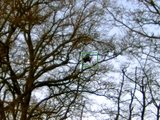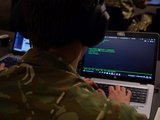Thales bags Qatar military SATCOM contract
Thales will supply the armed forces of Qatar with a military satellite communications system under a contract announced on 20 October.
The contract will see Thales provide the ground segment system needed to transmit and receive communications via satellite, and to process data on the ground. The system will provide Qatari ground and naval forces with a long-range communications capability to enhance national security.
The solution is built around Thales's System 21 technology to provide secure, high-data-rate transmissions. This fully proven system has been selected by several NATO countries.
The Network Operations Centre, also provided by Thales, will be used for planning and managing the complete system, which will be operated by the Qatari armed forces.
The solution will be interoperable with the other communications systems in service within the Qatar armed forces, including combat radios and fixed networks.
Abdulaziz Falah Al-Dosari, assistant for technology to the Minister of State for Defence Affairs, said: ‘We are today selecting Thales after a rigorous procurement process and over a year of technical evaluation. Thales has been chosen thanks to its technical solution.’
The solution will be delivered on a turnkey basis, and integrated teams will be set up to ensure the transfer of skills from Thales to the customer.
More from Digital Battlespace
-
![Chess Dynamics successfully demonstrates Vision4ce AI-driven tracker]()
Chess Dynamics successfully demonstrates Vision4ce AI-driven tracker
The Vision4ce Deep Embedded Feature Tracking (DEFT) technology software is designed to process video and images by blending traditional computer vision with artificial intelligence (AI) algorithms to present actionable information from complex environments.
-
![Wave Relay devices cleared for security use on commercial systems in industry trend]()
Wave Relay devices cleared for security use on commercial systems in industry trend
Persistent Systems has been cleared by National Security Agency (NSA) to transmit sensitive data on commercial networks. The devices are added to the NSA’s Commercial Solutions for Classified (CSfC) component list which also includes other companies’ products providing the same security.
-
![UK teases cyber spending boost in Strategic Defence Review ahead of “imminent” release]()
UK teases cyber spending boost in Strategic Defence Review ahead of “imminent” release
The release of the UK’s Strategic Defence Review (SDR) has been long promised as mid-year. It is possible it could be as early as 2 June although the UK Ministry of Defence (MoD) continues to play its cards close to its chest.
-
![Intelsat emphasises SATCOM resilience for SOF in contested domains (video)]()
Intelsat emphasises SATCOM resilience for SOF in contested domains (video)
Intelsat outlines how its multi-orbit SATCOM architecture is enhancing connectivity and resilience for special operations forces operating in degraded and contested environments.
-
![US Space Force’s next-generation missile warning system moves forward with $500 million in new contracts]()
US Space Force’s next-generation missile warning system moves forward with $500 million in new contracts
Next-Generation Overhead Persistent Infrared (Next-Gen OPIR) satellites are intended to provide early warning of missile launches from any location worldwide and new ground stations will result in expanded coverage of critical missile warning.























